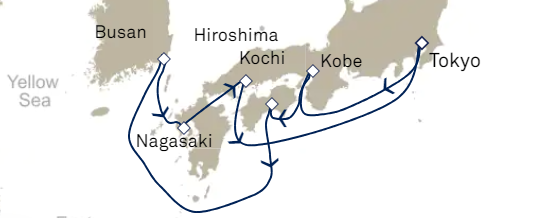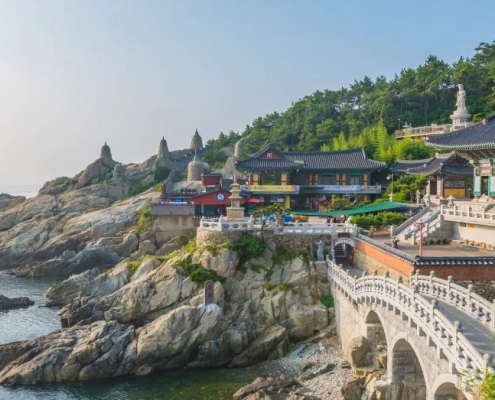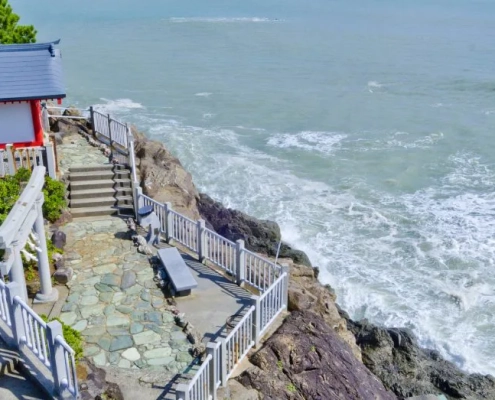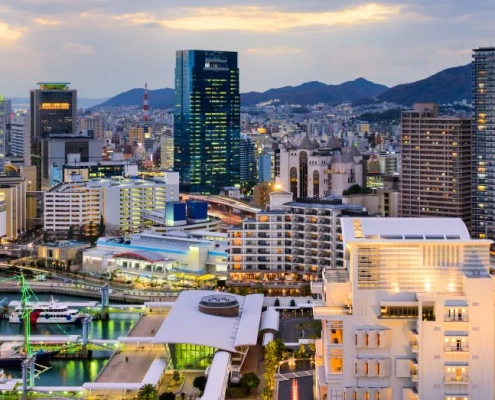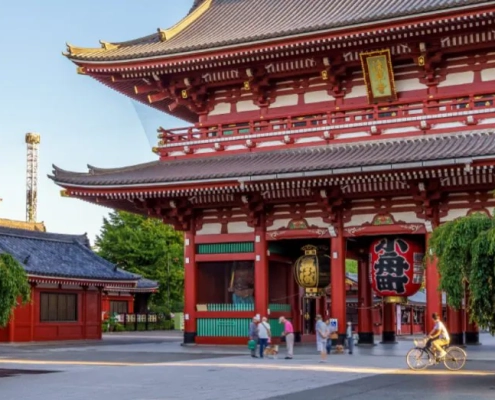Tokyo, Japan
Apr 26, 2024
\
Japan’s vibrant capital has beckoned visitors for many centuries, offering a perfect balance of futuristic curiosities and unique traditions.
Tokyo port guide
Streets adorned in colorful posters and neon signs. Beautifully decorated Shinto shrines. Sweet and spicy aromas escaping from local yatai (food stalls). Tokyo is a treat for the senses, bringing opportunities for unforgettable experiences at every corner.
Perhaps you’d love to simply get lost on purpose, among the unending high rises and contemporary architecture. Would you prefer to seek out a more tranquil spot, spending a quiet moment or two in one of the city’s fairy-tale-like parks? Should you prefer an active day, seeing as much as possible of this metropolis, you’ll find plenty of iconic landmarks to choose from.
Top landmarks and sights in Tokyo
While skyscrapers and modern architecture abound, so too do historic buildings and peaceful greenspaces. Take time to gaze skywards, peer round corners, wander beneath intricately carved archways, and be rewarded with a glimpse into Japan’s fascinating history and culture.
Tokyo Skytree
At 634 meters, Tokyo Skytree is one of the tallest structures in the world. It’s a broadcasting and observation tower, and on a clear day, not only does it offer a one-of-a-kind view of the sprawling city, but also the snow-capped slopes of Mount Fuji behind.
Shibuya Crossing
Tokyo is renowned for its contemporary feel and fast-pace, and nowhere is this more apparent than in the streets surrounding Shibuya Crossing. Known to be the world’s busiest crossing, where an estimated 3,000 people cross at one time, to many people this is the very essence of Tokyo.
Sensō-ji
You could choose to explore Japanese history and culture, at sites including the oldest temple in Tokyo, Sensō-ji. This Buddhist temple, first opened in 645 AD, showcases fine Japanese craftsmanship with its carefully carved pillars, walls, and curved red roofs.
Things to do in Tokyo
Tokyo is where past meets present. It’s where ornate details meet flashy blocks of color. It’s where you can spend a morning breathing in the scent of incense in a beautiful Buddhist temple, and an afternoon playing arcade games and shopping for shirts and spices in vending machines. No matter where your interests lie, you’ll find that Tokyo is a city with something for all.
Yoyogi Park
Escape the electric energy and flurry of Tokyo in Yoyogi Park, home to the ornate and photogenic Meiji Shrine. Parks like this offer a wonderful respite from the city streets, with plenty of green space, wooden sculptures, water features, and rippling ponds.
Arcades
Japan is known for colorful anime and video games, and there’s nowhere better to explore this side of the country than in one of Tokyo’s many arcades. The Akihabara district is home to plenty of arcades with hundreds of different games, including classics like Tekken and Super Mario.
Chiyoda City
In the center of Tokyo is the Chiyoda district, known as Chiyoda City. It’s here you’ll find the Imperial Palace, an iconic piece of ornate Japanese architecture, and home to Naruhito, the Emperor of Japan. A maze of streams and moats are framed by ornate stone walls and bridges, while at the same time contemporary architecture looms above picturesque gardens and fountains.
Eating and drinking near Tokyo
Sticky sweet treats. Delicate fresh fish. Nourishing bowls of flavorsome soup. Tokyo is a haven for foodies, offering plenty of new and interesting choices as well as some familiar favorites.
Many visitors to this part of the world go in search of the best sushi and sashimi. Sushi, typically raw pieces of salmon, prawns, or tuna is usually served with flavored rice and vegetables. Sashimi, on the other hand, comprises simple, thin-cut pieces of raw fish or meat served alone. Both perfectly showcase the skills of Japanese chefs and make for a fresh and light meal.
Ramen, miso soup, and udon noodles in broth are also excellent, lighter options. In these dishes, you’ll find a tasty stock base complimented by different vegetables, meat or tofu, noodles, and sometimes dumplings, along with a hearty goodness that will leave you feeling happy, full, and ready to explore.
Takoyaki is a wonderful snack when you’re looking for a little dessert. They’re small parcels made with pancake batter and can be filled with chocolate, custard, or red bean jam (anko). You could also try anmitsu, which is made with a gelatine-like ingredient called agar-agar and adzuki red beans, served with fruit and syrup.
Shopping in Tokyo
As a center of commerce, dealing in everything from electronics and technology to colorful anime toys and cutting-edge fashion, it will come as no surprise to learn that shopping in Tokyo is almost impossible to avoid. The different districts each offer their own charm, and often specialize in something different.
Ameyoko is a vibrant market street with vendors selling a wide variety. You’ll find dried food and spices just a few yards from another stall offering bags and clothes, and another with cosmetics. This street comes with an interesting history too; it was home to a black market selling American products after World War 2, and before that the main commodity was candy, hence the full name Ameya Yokocho, translating to ‘candy store alley’.
For more traditional and local goods, visit the Nihonbashi district. Here you’ll find the first branch of Japan’s department store, Mitsukoshi, as well as other shops with a history dating back centuries.
Getting around: Tokyo transport
While the cruise port is quite central, at more than 2,000km squared Tokyo cannot be described as a walkable city by any means. Luckily, Japanese public transport is reliably punctual and easy, and throughout Tokyo you’re never too far from a metro station. There is a station at the cruise terminal itself, and a train can take you almost anywhere you’d like to go in the city, with more than 175 stations located across 195km of track. It’s also easy to grab taxis in Tokyo if you’d prefer.
Tokyo port facilities
Opening in September 2020, Tokyo International Cruise Terminal is a modern facility featuring plenty of amenities. It was built to accommodate events as well as cruise passengers, and as such it boasts spacious meeting rooms, communal areas, and even an art gallery. There is also an observation deck on the fourth floor. For more basic needs, you’ll find toilets, Wi-Fi, a nursing room, and a smoking room.
Top tips for Tokyo
Currency
The currency used in Tokyo and throughout Japan is the Yen (JPY). At the time of writing, £1 GBP works out to around 163 JPY. Card payments are widely accepted in Tokyo, although it’s advisable to carry some cash if you’d like to visit smaller establishments, such as street food vendors, small cafes, and market stalls. You’ll find plenty of ATMs all over the city, or you can also purchase Yen on board your ship.
Tipping
Tipping is not expected in Japan, and many cafes and restaurants actually require you to pay your bill upfront, rather than after dining. The cultural expectation here is that you’ve already paid for good service by visiting the establishment, and the offer of a tip may even lead to an awkward scenario, as it’s likely to be turned down.
Weather
Tokyo is a city that sees all seasons. The coldest months are January and February, when temperatures sit at around 41 degrees Fahrenheit. The summer months of July and August, on the other hand, are much warmer at around 77 degrees Fahrenheit. Unfortunately, some of the warmer months are also when Tokyo sees the most rain, with June and September being the wettest.



